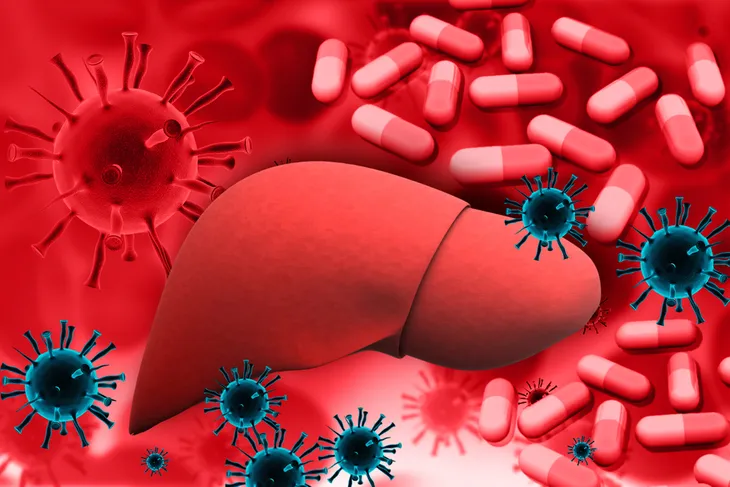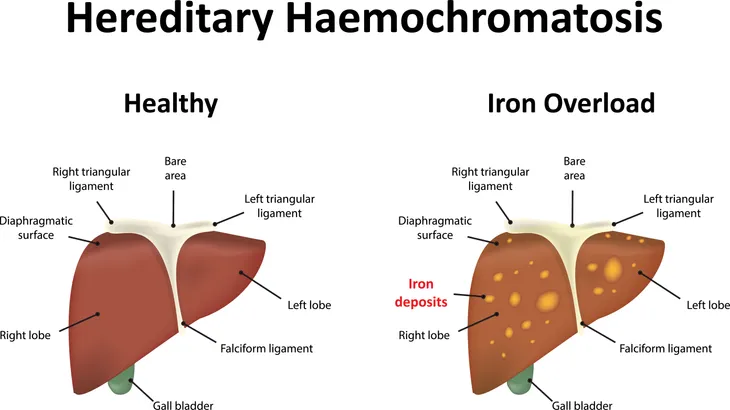Elevated liver enzymes are a marker of inflammation or damage to liver cells. Inflamed or injured liver cells cause the liver enzymes alanine transaminase (ALT) and aspartate transaminase (AST) to leak into the bloodstream. Mild elevations of ALT and AST are commonly discovered in individuals with no symptoms during routine blood work. In general, normal ranges for ALT are 7 to 56-units per liter, while normal ranges for AST are 10 to 40-units per liter. Mild elevations of both liver enzymes are 2 to 3-times higher than normal range.
Ten causes of elevated liver enzymes include…
1. Nonalcoholic Fatty Liver Disease
Nonalcoholic fatty liver disease (NAFLD) is the diagnosis used to describe an abnormal accumulation of fat in the liver of individuals who drink little or no alcohol. The disease is common and most individuals with the diagnosis show no signs or symptoms and have no complications. It is the most common cause of elevated liver enzymes. Risk factors for the development of NAFLD include obesity and type 2 diabetes.
Nonalcoholic fatty liver disease has two forms: hepatic steatosis and nonalcoholic steatohepatitis. It is estimated that 30-percent of adults in the United States have nonalcoholic fatty liver disease. Physicians expect more than 5 to 10-percent of the liver’s weight to be fat at the time of diagnosis of the disease. No standard treatment exists for NAFLD. The emphasis is on minimizing the contribution of risk factors commonly associated with NAFLD. Losing weight if obese and tight control of type 2 diabetes is highly recommended to decrease the odds of developing NAFLD.
2. Alcoholic Liver Disease
Alcoholic liver disease (ALD) represents injury to the liver as a result of alcohol abuse. Acetaldehyde is a toxic chemical produced by the breakdown of alcohol. All scientists agree that acetaldehyde damages the liver. The disease occurs after years of heavy drinking, but not all heavy drinkers go on to develop alcoholic liver disease. The amount of alcohol consumed is the most important risk factor for the development of ALD.
Alcoholic liver disease has three forms: fatty liver, alcoholic hepatitis, and cirrhosis. Fatty liver is generally reversible with abstinence from the consumption of alcohol. Alcoholic hepatitis develops with the consumption of large amounts of alcohol over a prolonged period of time. Cirrhosis involves the progressive replacement of normal liver tissue with scar tissue. As the burden of scar tissue increases, the function of the liver decreases. Abstinence from the consumption of alcohol is the most important factor in treatment of individuals suffering with alcoholic liver disease.
3. Medication-Associated Liver Injury
Many medications have been associated with liver injury and the elevation of liver enzymes. The most common cause of medication-associated liver injury is the over-the-counter pain reliever acetaminophen (Tylenol). Other pain relievers including aspirin, ibuprofen (Advil, Motrin), and naproxen (Aleve) can cause liver injury. Antibiotics can cause medication-associated liver injury. The antibiotic most frequently implicated in the development of the disease is amoxicillin/clavulanic acid (Augmentin). Other antibiotics causing medication-associated liver injury include sulfa agents and isoniazid (INH).
Medication-associated liver injury is the most common cause of acute liver failure in the United States. Medication-associated liver injury has two forms: predictable and idiosyncratic (unpredictable). Predictable liver injury is dose dependent. In other words, the higher the dose of medication ingested, the more damage sustained by the liver. Idiosyncratic liver injury is unpredictable. Medication-associated liver injury is the most common reason for the withdrawal of an approved prescription medication from the market.
4. Viral Hepatitis
Viral hepatitis describes inflammation of the liver due to a virus. In the United States, viral hepatitis is most commonly attributed to the hepatitis A virus (HAV), hepatitis B virus (HBV), and hepatitis C virus (HCV). It is estimated that 3.2-million in the United States have chronic hepatitis C, and 1.2-million have chronic hepatitis B. Individuals with chronic hepatitis are at increased to develop both cirrhosis and liver cancer.
The treatment of viral hepatitis varies. No antiviral therapy is available for the treatment of acute hepatitis A, B, and C. As a result, treatment is primarily supportive. There has been an extensive effort to prevent infection with hepatitis virus B through vaccination. Chronic infection with hepatitis B or C can be treated with interferon and ribavirin. Most recently the branded prescription drug Harvoni has been introduced for the treatment of chronic hepatitis C and cure rates as high as 96-percent have been reported.
5. Hemochromatosis
Hemochromatosis is an inherited disorder of iron metabolism. It is the most common cause of severe iron overload. Excess iron may be deposited into the liver. The abnormal accumulation of iron in the liver causes damage. As a result, levels of liver enzymes begin to elevate, especially AST and ALT. The three types of hemachromatosis are primary hemochromatosis, also known as hereditary hemochromatosis; secondary hemochromatosis; and neonatal hemochromatosis.
The key to the treatment of hemochromatosis is the removal of iron before it can cause irreversible organ damage. The sole recommended treatment for primary hemochromatosis is regularly scheduled removal of blood through phlebotomy, or bloodletting. Iron chelation agents such as deferoxamine are an alternative for individuals who are not candidates for regular phlebotomy. Chelation agents bind excess iron in the blood. Complications of hemochromatosis may include cirrhosis (extensive scarring of the liver) and liver cancer.
6. Alpha-1 Antitrypsin Deficiency
Alpha-1 antitrypsin deficiency is an inherited disorder that can lead to lung and liver damage. Alpha-1 antitrypsin is a protein that protects the lungs. The loss of this protein’s protection leads to the destruction of air sacs in the lungs, which is termed emphysema. The liver produces alpha-1 antitrypsin, and if the protein is not the right shape excess levels will accumulate in liver cells and cause damage. The liver damage leads to elevated liver enzymes, especially ALT and AST.
Alpha-1 antitrypsin deficiency is characterized by the production of little to no alpha-1 antitrypsin in the body. The key to the treatment of alpha-1 antitrypsin deficiency is preventing or slowing lung and liver damage. Quitting smoking is imperative to the treatment of emphysema secondary to alpha-1 antitrypsin deficiency. Vaccination against both hepatitis A and B is recommended to decrease the likelihood of significant liver disease.
7. Wilson Disease
Wilson disease is a rare inherited disorder of copper metabolism. It is characterized by the deposition of excess copper in the liver, brain, eyes, and other organs. The excess copper levels can cause life-threatening organ damage. The most unique sign of Wilson disease is Kayser-Fleischer rings, which result from the buildup of copper in the eye. The rings are described as a rusty-brown ring around the edge of the iris (colored part of eye).
Excess copper causes liver damage resulting in elevated liver enzymes, especially ALT and AST. Liver complications of Wilson disease may include cirrhosis (scarring of the liver), liver failure, and liver cancer. Analyzing the copper content of liver may be helpful for the diagnosis of Wilson disease. The mainstay of treatment are chelating agents that bind excess copper and remove it from the bloodstream. Examples of chelating agents used to treat Wilson disease are trientine (Syprine) and d-pencillamine.
8. Mononucleosis
Mononucleosis, or “mono”, is an infectious disease caused by the Epstein-Barr virus. It is sometimes called “the kissing disease” because it can be transmitted through saliva. The disease is most common among teenagers and young adults. Key symptoms of mononucleosis include extreme fatigue, fever, sore throat, and swollen lymph nodes in the neck. A monospot blood test is usually positive and can diagnose mononucleosis by detecting the presence of antibodies to the Epstein-Barr virus.
Complications of mononucleosis may include enlargement of the spleen and inflammation of the liver. Inflammation of the liver, or hepatitis, causes elevated liver enzymes, specifically ALT and AST. No specific therapy exists for the treatment of mononucleosis. Treatment is mainly supportive and may include bed rest, sound nutrition, and drinking plenty of fluids. The prognosis for mononucleosis is excellent, and severe complications are rare.
9. Cytomegalovirus Infection
Cytomegalovirus (CMV) is a very common virus. By age 40, the majority of adults in the United States have had a cytomegalovirus infection. Many cytomegalovirus infections produce no symptoms and individuals are unaware of being exposed. The virus can cause symptoms in individuals with a weakened immune system and newborns of mothers who contracted the disease during pregnancy. Cytomegalovirus is usually spread through close contact with body fluids such as blood, saliva, urine, semen, and breast milk.
Cytomegalovirus is related to the viruses causing chickenpox, herpes, and mononucleosis. The virus leads to a chronic infection, although it mainly stays dormant and can be reactivated. In newborns and individuals with a weakened immune system, cytomegalovirus may lead to inflammation of the liver, or hepatitis. Hepatitis causes liver damage, which is reflected by elevated liver enzymes (ALT/AST). There is no cure for a CMV infection, although antiviral medications can slow viral reproduction.
10. Autoimmune Hepatitis
Autoimmune hepatitis is a disease characterized by the body’s own immune system attacking the liver and causing inflammation of the liver, or hepatitis. The body’s immune system normally attacks bacteria, viruses, and other foreign agents. It is not supposed to attack its own cells. The exact cause of autoimmune hepatitis is unknown, but genetics and environmental factors may play a role in the development of the disease.
Autoimmune hepatitis is a chronic condition and can lead to liver damage, which causes elevated liver enzymes (ALT/AST). There are two forms of autoimmune hepatitis: type 1 (most common form) and type 2. The mainstays of treatment for autoimmune hepatitis are agents that suppress the immune response to the liver. Steroids such as prednisone may be used, but long-term use of steroids can lead to complications such as diabetes, osteoporosis, high blood pressure, weight gain, and glaucoma. As symptoms improve the steroid dose is decreased, azathioprine (an immunosuppressive drug) may be added.













